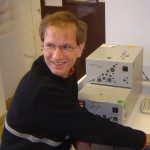Link to Pubmed [PMID] – 22098633
Mol. Microbiol. 2011 Dec;82(6):1422-32
A crucial aspect of the functionality of bacterial type II secretion systems is the targeting and assembly of the outer membrane secretin. In the Klebsiella oxytoca type II secretion system, the lipoprotein PulS, a pilotin, targets secretin PulD monomers through the periplasm to the outer membrane. We present the crystal structure of PulS, an all-helical bundle that is structurally distinct from proteins with similar functions. Replacement of valine at position 42 in a charged groove of PulS abolished complex formation between a non-lipidated variant of PulS and a peptide corresponding to the unfolded region of PulD to which PulS binds (the S-domain), in vitro, as well as PulS function in vivo. Substitutions of other residues in the groove also diminished the interaction with the S-domain in vitro but exerted less marked effects in vivo. We propose that the interaction between PulS and the S-domain is maintained through a structural adaptation of the two proteins that could be influenced by cis factors such as the fatty acyl groups on PulS, as well as periplasmic trans-acting factors, which represents a possible paradigm for chaperone-target protein interactions.

